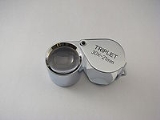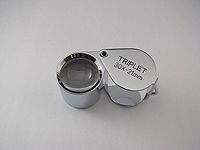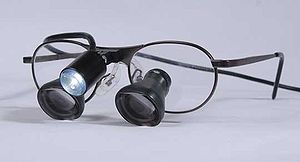
Loupe
Encyclopedia

Magnification
Magnification is the process of enlarging something only in appearance, not in physical size. This enlargement is quantified by a calculated number also called "magnification"...
device used to see small details more closely. Unlike a magnifying glass
Magnifying glass
A magnifying glass is a convex lens that is used to produce a magnified image of an object. The lens is usually mounted in a frame with a handle ....
, a loupe does not have an attached handle, and its focusing
Focus (optics)
In geometrical optics, a focus, also called an image point, is the point where light rays originating from a point on the object converge. Although the focus is conceptually a point, physically the focus has a spatial extent, called the blur circle. This non-ideal focusing may be caused by...
lens(es)
Lens (optics)
A lens is an optical device with perfect or approximate axial symmetry which transmits and refracts light, converging or diverging the beam. A simple lens consists of a single optical element...
are contained in an opaque
Opacity (optics)
Opacity is the measure of impenetrability to electromagnetic or other kinds of radiation, especially visible light. In radiative transfer, it describes the absorption and scattering of radiation in a medium, such as a plasma, dielectric, shielding material, glass, etc...
cylinder
Cylinder (geometry)
A cylinder is one of the most basic curvilinear geometric shapes, the surface formed by the points at a fixed distance from a given line segment, the axis of the cylinder. The solid enclosed by this surface and by two planes perpendicular to the axis is also called a cylinder...
or cone
Cone (geometry)
A cone is an n-dimensional geometric shape that tapers smoothly from a base to a point called the apex or vertex. Formally, it is the solid figure formed by the locus of all straight line segments that join the apex to the base...
. Loupes are also called hand lenses (or nose lenses - see below).
Optics
Three basic types of loupes exist. The first is a simple lens and results in the least amount of magnification. The second is the Galilean system which uses multiple lenses, resulting in higher magnification. The last is the prismatic loupe system which employs both lenses and prisms to reflect and focus light, resulting in the highest degree of magnification.Uses
Loupes are used in a number of industries, notably the jewelry trade, watchmaking, photography, printing, dentistryDentistry
Dentistry is the branch of medicine that is involved in the study, diagnosis, prevention, and treatment of diseases, disorders and conditions of the oral cavity, maxillofacial area and the adjacent and associated structures and their impact on the human body. Dentistry is widely considered...
, education
Education
Education in its broadest, general sense is the means through which the aims and habits of a group of people lives on from one generation to the next. Generally, it occurs through any experience that has a formative effect on the way one thinks, feels, or acts...
and ophthalmology
Ophthalmology
Ophthalmology is the branch of medicine that deals with the anatomy, physiology and diseases of the eye. An ophthalmologist is a specialist in medical and surgical eye problems...
. Loupes are also used in academia and life sciences, such as geology
Geology
Geology is the science comprising the study of solid Earth, the rocks of which it is composed, and the processes by which it evolves. Geology gives insight into the history of the Earth, as it provides the primary evidence for plate tectonics, the evolutionary history of life, and past climates...
and biology
Biology
Biology is a natural science concerned with the study of life and living organisms, including their structure, function, growth, origin, evolution, distribution, and taxonomy. Biology is a vast subject containing many subdivisions, topics, and disciplines...
. Amateur naturalists may also find a hand lens or a loupe a useful tool when looking at or identifying species.
Jewelers
Jewelers typically use a monocularMonocular
A monocular is a modified refracting telescope used to magnify the images of distant objects by passing light through a series of lenses and sometimes prisms; the use of prisms results in a lightweight telescope. Volume and weight are less than half those of binoculars of similar optical...
, handheld loupe in order to magnify gemstone
Gemstone
A gemstone or gem is a piece of mineral, which, in cut and polished form, is used to make jewelry or other adornments...
s and other jewelry that they wish to inspect. A 10x magnification is good to use for inspecting jewelry and hallmarks and is the Gemological Institute of America
Gemological Institute of America
The Gemological Institute of America, or GIA, is a nonprofit institute dedicated to research and education in the field of gemology and the jewelry arts. Founded in 1931, GIA's mission is to protect all buyers and sellers of gemstones by setting and maintaining the standards used to evaluate...
's standard for grading diamond
Diamond
In mineralogy, diamond is an allotrope of carbon, where the carbon atoms are arranged in a variation of the face-centered cubic crystal structure called a diamond lattice. Diamond is less stable than graphite, but the conversion rate from diamond to graphite is negligible at ambient conditions...
clarity
Clarity
Clarity may refer to:* Clarity , 2010* Clarity , 1999* Clarity * Clarity , a song by John Mayer* Honda FCX Clarity, a hydrogen fuel cell automobile* Clarity Act, Canadian bill C-20...
. The stone will sometimes be inspected at higher magnifications, although inclusions and blemishes must be visible at 10x to affect the grade.
Watchmaking
Loupes are employed to assist watchmakers in assembling mechanical watches. Many aspects require the use of the loupe, in particular the assembly of the watch mechanism itself, the assembly and details of the watch dial, as well as the formation of the watch strap and installation of precious stones onto the watch face.Photography
Analog (filmFilm
A film, also called a movie or motion picture, is a series of still or moving images. It is produced by recording photographic images with cameras, or by creating images using animation techniques or visual effects...
) photographers use loupes to review, edit or analyze negatives
Photographic film
Photographic film is a sheet of plastic coated with an emulsion containing light-sensitive silver halide salts with variable crystal sizes that determine the sensitivity, contrast and resolution of the film...
and slides on a light table
Light table
A light table is a viewing device that is used to review photographic film or artwork placed on top of it. It provides even illumination of the subject from below through a translucent cover and fluorescent lights that emit little heat. They can also be found mounted on the walls of hospitals and...
. Photographers using large format
Large format
Large format refers to any imaging format of 4×5 inches or larger. Large format is larger than "medium format", the 6×6 cm or 6×9 cm size of Hasselblad, Rollei, Kowa, Pentax etc cameras , and much larger than the 24×36 mm frame of 35 mm format.The main advantage...
cameras also use a loupe to view the ground glass
Ground glass
Ground glass is glass whose surface has been ground to produce a flat but rough finish.Ground glass surfaces have many applications, ranging from mere ornamentation on windows and table glassware to scientific uses in optics and laboratory glassware....
image to aid in focusing. DSLR
Digital single-lens reflex camera
Most digital single-lens reflex cameras are digital cameras that use a mechanical mirror system and pentaprism to direct light from the lens to an optical viewfinder on the back of the camera....
camera users also use loupes to help to identify dust and other particles on the sensor, in preparation for sensor cleaning.
Printing
Offset and flexographic printing see frequent use of loupes in order to carefully analyze how ink lies on paper. Strippers use loupes in order to register film separations to one another. Pressmen use them to check registration of colors, estimate dot-gain, and diagnose issues with roller pressure and chemistry based on the shape of individual dots and rosettes.Dentistry

Dentist
A dentist, also known as a 'dental surgeon', is a doctor that specializes in the diagnosis, prevention, and treatment of diseases and conditions of the oral cavity. The dentist's supporting team aides in providing oral health services...
s use loupes to better scrutinize the entities within their patients' mouths in order to make a better diagnosis, for example, to determine how far a crack proceeds along the surface of a tooth. Loupes are also used in order to perform on a more precise level; while dentists drill teeth on a millimeter scale, magnification can enlarge the dentists' view of the teeth, perhaps making it easier to inspect teeth for decay and/or see things that ordinarily would not be seen without magnification.
Specialties of dentistry, such oral surgery
Oral Surgery
Oral Surgery is a recognized international specialty in dentistry. It includes the diagnosis, surgical and related treatment of diseases, injuries and defects involving both the functional and esthetic aspects of the hard and soft tissues of the head, mouth, teeth, gums, jaws and neck.It involves,...
and periodontics, may benefit from the use of loupes as well. The oral cavity is notorious for being a place containing small entities with limited access. Magnification can be very helpful when suturing a flap.
Because dentists use both of their hands while performing dental procedures, dental loupes are binocular
Binocular vision
Binocular vision is vision in which both eyes are used together. The word binocular comes from two Latin roots, bini for double, and oculus for eye. Having two eyes confers at least four advantages over having one. First, it gives a creature a spare eye in case one is damaged. Second, it gives a...
and usually take on the form of a pair of glasses
Glasses
Glasses, also known as eyeglasses , spectacles or simply specs , are frames bearing lenses worn in front of the eyes. They are normally used for vision correction or eye protection. Safety glasses are a kind of eye protection against flying debris or against visible and near visible light or...
. Some dental loupes are flip-types, which take the form of two small cylinders, one in front of each lense of the glasses. Other types are inset within the lens of the glasses. A typical magnification for use in dentistry is 2.5x, but dental loupes can be anywhere in the range from 2x to 8x.
Together with proper access to the oral cavity, light
Lamp (electrical component)
A lamp is a replaceable component such as an incandescent light bulb, which is designed to produce light from electricity. These components usually have a base of ceramic, metal, glass or plastic, which makes an electrical connection in the socket of a light fixture. This connection may be made...
is an important part of performing precision dentistry. Because a dentist's head often eclipse
Eclipse
An eclipse is an astronomical event that occurs when an astronomical object is temporarily obscured, either by passing into the shadow of another body or by having another body pass between it and the viewer...
s the overhead dental lamp, loupes may be fitted with a light source. Loupe-mounted lights used to be fed by fiber optic cables that connected to either a wall-mounted or table-top light source. Newer models feature a more convenient LED
LEd
LEd is a TeX/LaTeX editing software working under Microsoft Windows. It is a freeware product....
lamp within the loupe-mounted light and an electric cord coming from either the conventional wall-mounted/table-top light source or a belt clip rechargeable battery
Rechargeable battery
A rechargeable battery or storage battery is a group of one or more electrochemical cells. They are known as secondary cells because their electrochemical reactions are electrically reversible. Rechargeable batteries come in many different shapes and sizes, ranging anything from a button cell to...
pack. Options for loupe-mounted camera
Camera
A camera is a device that records and stores images. These images may be still photographs or moving images such as videos or movies. The term camera comes from the camera obscura , an early mechanism for projecting images...
s and video recorders are also available.
Surgery
Surgeons in many specialties commonly use loupes when doing surgery on delicate structures. The Loupes used by surgeons are mounted in the lenses of glasses and are custom made for the individual surgeon, taking into account their corrected vision, interpupillary distance and desired focal distance. Multiple magnification powers are available.Geology
The loupe (hand lens) is a vital geological field tool used to identify small mineral crystals and structures in rocks.Biology
Loupes are used by professional and amateur field biologists for help identifying species in field situations where a full-sized microscope is impractical, but the ability to observe small morphological characteristics is desired. Many floras (Flora (book)Flora (book)
A Flora is a book or other work which describes the plant species occurring in an area or time period, often with the aim of allowing identification. Some classic and modern floras are listed below....
) and diagnostic keys (Single-access key
Single-access key
A 'key' in Biology is a modeling method used for categorizing species using logical choices. A single-access key is a key where the sequence and structure of identification steps is fixed by the author of the key...
) for identifying plant or animal species recommend having a loupe at hand, because minute details like the presence of hairs, shapes of hairs and glands separate taxa.
Meteoritics
Scientists in the Meteoritics and Planeteary Science field as well as private collectors of meteorites use loupes as one of their primary tools in meteorite classification and study, and also for simple examination in the field during meteorite recovery.Electronics
Due to the extremely small size of many modern surface-mountSurface-mount technology
Surface mount technology is a method for constructing electronic circuits in which the components are mounted directly onto the surface of printed circuit boards . An electronic device so made is called a surface mount device...
components used in compact electronics, engineers often use a loupe to inspect the completed circuit board
Printed circuit board
A printed circuit board, or PCB, is used to mechanically support and electrically connect electronic components using conductive pathways, tracks or signal traces etched from copper sheets laminated onto a non-conductive substrate. It is also referred to as printed wiring board or etched wiring...
for manufacturing defects such as solder bridging and missing or misaligned components. While soldering or reworking surface-mount components by hand, a loupe is sometimes essential for identifying and aligning parts. Due to the ever-decreasing size of electronic components, the need for magnification is increasingly becoming a factor in circuit-building.
Tattooing
Tattoo artists use loupes to inspect the quality of their needle tips. They do this to ensure the least amount of damage possible to the skin surface.Numismatists and coin collectors
Loupes are an essential tool in both numismaticsNumismatics
Numismatics is the study or collection of currency, including coins, tokens, paper money, and related objects. While numismatists are often characterized as students or collectors of coins, the discipline also includes the broader study of money and other payment media used to resolve debts and the...
, the study of currency, and the related practice of coin collection
Coin collecting
Coin collecting is the collecting or trading of coins or other forms of minted legal tender.Coins of interest to collectors often include those that circulated for only a brief time, coins with mint errors and especially beautiful or historically significant pieces. Coin collecting can be...
. Coin
Coin
A coin is a piece of hard material that is standardized in weight, is produced in large quantities in order to facilitate trade, and primarily can be used as a legal tender token for commerce in the designated country, region, or territory....
collectors frequently employ loupes for better evaluation of the quality of their coins, since identifying surface wear is vital when attempting to classify the grade of a coin. Uncirculated coins (coins without wear) can command a substantial premium over coins with slight wear. This wear cannot always be seen with the naked eye. Numismatists can also employ loupes to identify some counterfeit
Counterfeit
To counterfeit means to illegally imitate something. Counterfeit products are often produced with the intent to take advantage of the superior value of the imitated product...
coins that would pass a naked-eye visual inspection.
Philatelists and stamp collectors
StampPostage stamp
A postage stamp is a small piece of paper that is purchased and displayed on an item of mail as evidence of payment of postage. Typically, stamps are made from special paper, with a national designation and denomination on the face, and a gum adhesive on the reverse side...
collectors employ loupes to improve their ability to evaluate the quality of their stamps. Identifying surface, adhesive, and perforation is vital when attempting to classify the grade of a stamp. Mint stamps (stamps without wear) can command a substantial premium over stamps with slight wear. This wear cannot always be seen with the naked eye. Practitioners of philately
Philately
Philately is the study of stamps and postal history and other related items. Philately involves more than just stamp collecting, which does not necessarily involve the study of stamps. It is possible to be a philatelist without owning any stamps...
, the study of postage and revenue stamps, also employ loupes to identify counterfeit
Counterfeit
To counterfeit means to illegally imitate something. Counterfeit products are often produced with the intent to take advantage of the superior value of the imitated product...
stamps that would pass naked-eye inspections.

